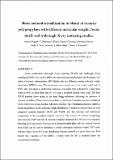Por favor, use este identificador para citar o enlazar a este item:
http://hdl.handle.net/10261/80944COMPARTIR / EXPORTAR:
 SHARE SHARE
 CORE
BASE CORE
BASE
|
|
| Visualizar otros formatos: MARC | Dublin Core | RDF | ORE | MODS | METS | DIDL | DATACITE | |

| Título: | Shear-induced crystallization of isotactic polypropylene with different molecular weight distributions: In situ small- and wide-angle X-ray scattering studies |
Autor: | Nogales, Aurora CSIC ORCID; Hsiao, Benjamin S.; Somani, Rajesh H.; Srinivas, Srivatsan; Tsou, Andy H.; Baltá Calleja, Francisco José CSIC ORCID; Ezquerra, Tiberio A. CSIC ORCID | Fecha de publicación: | 2001 | Editor: | Elsevier | Citación: | Polymer 42: 5247- 5256 (2001) | Resumen: | In situ synchrotron wide-angle X-ray scattering (WAXS) and small-angle X-ray scattering (SAXS) were used to monitor the structural and morphological developments during crystallization of a series of isotactic polypropylene (iPP) blends with different molecular weight distributions (MWD). The experiments were carried out in the undercooled melt at 150°C subjected to a high shear strain (1428%) at a fixed shear rate (57 s-1). The final WAXS patterns showed arcing of the main Bragg reflections, indicating the presence of oriented crystallites. These oriented crystallites, in the form of lamellae, were also revealed by two strong meridional reflections in the SAXS patterns. The crystallization kinetics exhibited a strong dependence on the molecular weight distribution, which were due to the production of primary nuclei induced by orientation. A method to deconvolute the total integrated scattered intensity (SAXS and WAXS) into the isotropic and anisotropic contributions from the crystallized polymer was used to analyze the data. The fraction of oriented morphology determined by SAXS and that of oriented crystallinity determined by WAXS showed good agreement with each other. However, it has been demonstrated that the oriented fraction from SAXS is more suitable for determining the 'critical orientation molecular weight' (M*) value. Only polymer chains above M* in the distribution can become oriented at a given shear rate. It is observed that, regardless of the MWD, a similar value for M* is obtained under our experimental conditions. © 2001 Elsevier Science Ltd. | URI: | http://hdl.handle.net/10261/80944 | DOI: | 10.1016/S0032-3861(00)00919-8 | Identificadores: | doi: 10.1016/S0032-3861(00)00919-8 issn: 0032-3861 |
| Aparece en las colecciones: | (CFMAC-IEM) Artículos |
Ficheros en este ítem:
| Fichero | Descripción | Tamaño | Formato | |
|---|---|---|---|---|
| Shear induced crystallization in blend of isotactic polypropilene.pdf | 1,06 MB | Adobe PDF |  Visualizar/Abrir |
CORE Recommender
SCOPUSTM
Citations
281
checked on 12-may-2024
WEB OF SCIENCETM
Citations
270
checked on 25-feb-2024
Page view(s)
353
checked on 17-may-2024
Download(s)
209
checked on 17-may-2024
Google ScholarTM
Check
Altmetric
Altmetric
NOTA: Los ítems de Digital.CSIC están protegidos por copyright, con todos los derechos reservados, a menos que se indique lo contrario.
